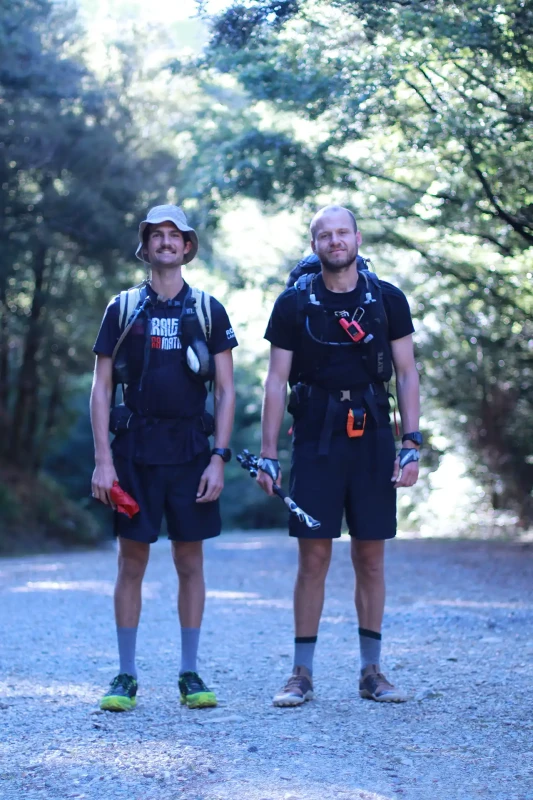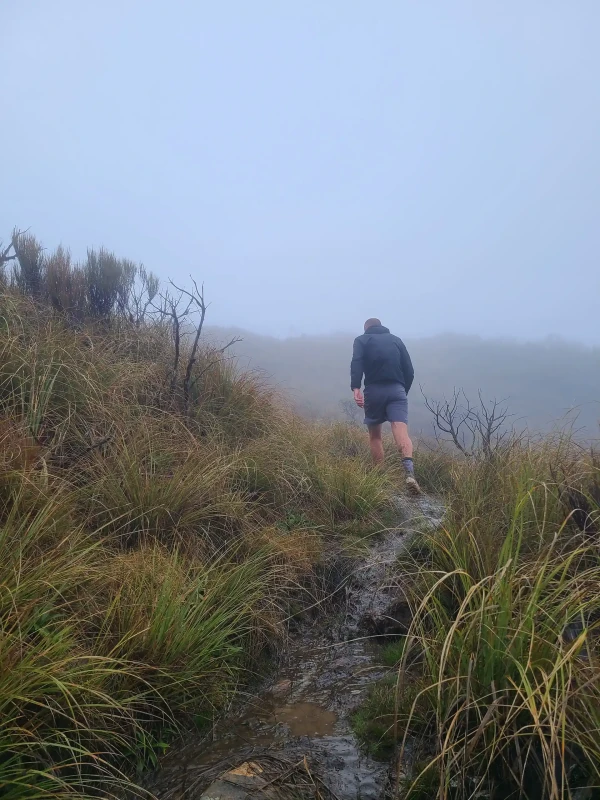Fast and Light: Lessons From Te Araroa
On 1 October 2024, Stefan Ozich embarked on an admirable endurance challenge and fundraising mission. His goals: run Te Araroa north to south and back again in the fastest known time (FKT), and raise $1 million for The Last Chance Project for men’s mental health, a topic close to his heart, after his brother tragically took his own life last year.
Things had gone to plan until Day 28, when Stefan and his support runner for the leg, Sam Pendreigh, learnt some crucial safety lessons. Sam shares the experience here so others can learn from their mistakes.
Day 27
Our plan was to hike up from Poads Road to Waiopehu Hut in the evening, and then attack the Tararua section the next day, with the hope of calmer weather. We’d packed our overnight bags for this leg, with our dry kit, food for 2 days, sleeping bags and additional wet weather gear. We changed the plan last-minute when Stefan arrived at the final aid station for the day behind schedule. Instead, we decided to stay in the Poads Road carpark, get some good sleep and then complete the full Tararua section the next day. So that we could travel as fast as possible, we repacked lighter, leaving our dry kit, extra food, sleeping bags and additional wet weather gear behind.
Day 28
The Tararua Range is one of the more challenging sections of Te Araroa. It has a reputation for extreme weather, and we were attempting it just outside the recommended Te Araroa season of November to April. The route involves steep ascents and descents, with some unmarked sections. It starts at 150 m, with its highest point Mount Crawford at 1,463 m.
We’d done our research, so we knew what we were getting into. Our friends and fellow ultra runners, Scott Bougen and Shaun Collins, had warned us about the range, as they’d been caught out before, but were able to turn back safely.
Our new plan was to get 46 km in the bag, which we estimated would take us 5-6 hours. From Poads Road we’d run to Dracophyllum Hut via Waiopehu Hut (23 km) and on to Parawai Lodge via Nichols Hut and Waitewaewae Hut (23 km). The forecast showed rain, but we’d been wet on other sections, and because we were aiming for the FKT, we were used to getting things done – rain, hail or shine. Our friends were meeting us with more supplies at Otaki Forks so we could travel light and therefore faster than the weather window… or so we’d hoped.
When we set off at 5.30 am, it wasn’t raining but there’d just been a torrential downpour and others through the night. We were only half an hour in when it started to rain. By the time we reached, Waiopehu Hut, we’d had pretty consistent rain the whole time and there was lots of mud.
After a 10-minute break at the hut, we headed off again. There was no question that we’d keep going because we were determined to meet our goal for the day, so we didn’t reassess our situation, despite feeling pretty miserable. We'd done sections like this before, which were longer and at higher elevations, so we thought we'd just be able to muscle our way through.
On the way to Dracophyllum Hut, we were fully exposed to freezing 60-80 km winds on the ridgeline, and being pelted with rain, sleet and snow. We couldn’t stop on the ridgeline, but when we got back into the treeline and out of the elements, we both looked at each other and admitted we could be out of our depth. The only thing we could do was push on and get to the hut, and then reevaluate.
By the time we reached the hut, we weren’t in the best of shape – we were chilled to the bone and wet through. The situation was real gnarly and we were seriously tossing up if it was a smart move to keep going with the weather and the daylight we had left, or if we needed to call someone to get us out. Stef confided that he’d been on the verge of an anxiety attack along the way, and seriously thought he was going to die.
The truth was, we hadn’t made smart decisions, and we were significantly underprepared in an effort to move fast and light so we could reach our goal. We didn’t have enough warm layers or food for a night out. Between us, we had just two muesli bars left and Stef's emergency blanket was ripped. To keep warm, Stef resorted to unzipping the mattress protector on the bunk bed and climbing inside.
We weighed up the risk and rewards of continuing. There was a lot of soul searching. If we kept going, we knew we’d face another exposed ridgeline in rain, and we were already both freezing and soaked. The risk of one of us getting hypothermia vs being one day closer to our goal didn’t make sense. We figured it’s better to live another day than die trying, so we sent out a call for help using our inReach. Land Search and Rescue (LandSAR) messaged back to say the weather was unflyable so we were looking at a night on our own. It was a pretty intense time.
Thankfully, there was a break in the weather long enough for an Air Force chopper to get in and take us out.
The experience was a wake-up call before we hit the South Island, where sections like this are longer and more isolated.
Day 30
After taking a day off to reflect on what had happened on Day 28, we felt ready to have another go at tackling the Tararua section after seeing a slight opening in the weather. Learning from that experience, we were better prepared, with more kit and better weather, so we expected it to go well. This time we had our full wet weather gear, gloves, thermals and spare food. We had also chosen Waiopehu Hut as a turnaround point, where we would check in with each other and the conditions, and decide whether we should continue.
The day started off positively, but then it quickly dawned on us that what was forecast wasn't entirely matching what we were seeing on the ground. In a torrential downpour we had some hail, which showed the freezing level hadn’t risen as much as we’d thought it would.
Even though we were carrying about 4-5kg of extra gear, we made it to Waiopehu Hut in the same time, which goes to show that being a prepared with the right gear wasn’t going to slow us down.
When we reached the hut, we were cold and the weather wasn’t getting any better. After a long discussion, we made the tough and frustrating – but wise – decision to turn around. It was the right call. As soon as we left the hut to head down, we had the biggest rainfall of the day, and although it eased up a bit, it kept raining. The track was turning to streams, and we were pretty happy to be getting out of it.
The outcome meant Stef’s hope of achieving the FKT is now well and truly over. It’s not the end of the world, with that knock to the mission, it now allows Stef to double-down on his focus of running Te Araroa twice and drawing attention to men’s mental health.
Stef’s new plan was to skip the 46 km Tararua section, take a bypass from Poads Road to Otaki Forks and rejoin Te Araroa at Parawai Lodge.
We've all heard stories like this before, but don't be underprepared like us - get prepared before you go on your next outdoor mission.
Key Takeaways
- Be prepared for a night out: Get all the info you can on how to prepare for your trip, get the right kit and allow for contingencies that could mean you have to spend a night in a cold hut or the bush.
- Take all the gear: Take a waterproof jacket, warm layers, a shelter and extra food in case you have to spend an unplanned night out.
- Extra gear won’t slow you down: Despite carrying 4-5kg of extra kit, we made the same time to Waiopehu Hut. It just goes to show that being prepared doesn’t have any downsides and is totally worth it.
- Always take an emergency communication device: Carrying an inReach (supplied by our sponsor TrackMe) could have saved our lives and enabled us to have two-way communication with the search and rescue team.
- Set key decision-making points: Before we set off on Day 30, we agreed that Waiopehu Hut would be the point where we’d discuss our options and decide our next move. This predetermined decision-making point allowed us to assess the conditions and make the wise decision to turn back.
- Always have a Plan B: Things don’t always go as planned, so decide what your Plan B will be before you leave. Having a Plan B will make changing your plans less of a mental shift. On Day 30, our Plan B was turning around at Waiopehu Hut.
- Listen to everyone in your team: Everyone needs to feel confident for the plan to be successful. If someone in your team isn’t keen to keep going, pull the pin. There’s no win in dragging someone along. Stefan wasn’t keen to keep going on Day 30 and that sealed the decision.
- Don’t risk a life and death situation: You may be hell-bent on a goal, but when it comes to life and death, if you’re not confident of success, make the call to change your plans. Read more about avoiding the ‘commitment’ trap and other mental shortcuts here.
- Make peace with your decision: It was hard not to do the Tararua section of Te Araroa, but at the end of the day, we’re happy with the call we made.
Stefan and Sam give a huge thanks to Horowhenua Land Search and Rescue and RNZAF for putting together and executing a rescue, and their sponsor, TrackMe, for supplying them with an InReach. You can donate to Stefan’s Givealittle page for men’s mental health here.
PHOTO CREDITS: Header - Caleb Smith | Samuel and Stefan - Mark John | Stefan on Te Araroa Trail - Samuel Pendreigh

